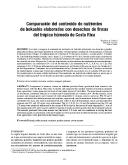| dc.description.abstract | Se evaluó y comparó el contenido de nutrientes de bokashis elaborados con desechos agrícolas generados en fincas del trópico húmedo de Costa Rica. El experimento consistió de 10 tratamientos, el bokashi tradicional como testigo y 9 combinaciones de 3 fuentes de N (bovinaza, cerdaza, y arachis-poró) y 3 fuentes de C de fácil degradación (banano, yuca y ñame). Las 3 fuentes de N y de C fueron usadas como sustitutas de la gallinaza y de la semolina utilizadas en el bokashi tradicional. El raquis de banano fue usado como sustituto de cascarilla de arroz. Después de 21 días de degradación, se determinaron los contenidos de macronutrientes, micronutrientes y las relaciones C:N y C:P de los bokashis. Los contenidos de N, C, P, K Cu, Ca y Zn y las relaciones C:N y C:P fueron influenciados positivamente por las fuentes de N, pero no así por las fuentes de C de fácil degradación. Cualquiera de las combinaciones de las 3 fuentes de N con las de C produjo un bokashi de calidad similar o mejor que el bokashi tradicional. El bokashi con cerdaza tuvo la relación C:N más baja y fue considerado el de mejor calidad nutricional. En conclusión, un bokashi de calidad similar o mejor que el bokashi tradicional puede ser elaborado con desechos agrícolas producidos en el trópico húmedo. This study evaluated and compared the nutrient content in bokashis produced from agricultural wastes generated on farms of the humid tropics of Costa Rica. The experiment consisted of 10 treatments, traditional bokashi as a control and 9 combinations of 3 sources of N (bovine manure, swine manure, and araquis-poró) and 3 sources of easily degradable C (banana, cassava and yam). The N and C sources substituted the chicken manure and semolina, respectively, used in traditional bokashi. Banana raquis substituted rice bran, also used in traditional bokashi. After 21 days of degradation, macro and micronutrient contents and C:N and C:P ratios were determined. The N, C, P, K, Cu, Ca and Zn contents and the C:N and C:P ratios were positively influenced by the source of N, but not by the source of easily degradable C. Any of the combinations of N and C sources yielded a bokashi of similar or better quality than the traditional bokashi. The bokashi produced with swine manure had the lowest C:N ratio and was considered as having the best nutritional quality. In conclusion, bokashi of similar or better quality than traditional bokashi can be produced from agricultural waste generated in the humid tropics. | es_ES |


